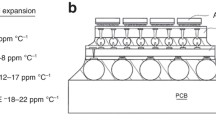Microvias of 50 μm diameter in a Si chip were filled with Zn or Sn-Zn to form through-silicon vias by means of an electroplating/reflow process or a dipping method. In the case of the electroplating/reflow process, Zn was electroplated on a Cu seed layer in via holes, and a reflow was then performed to fill the via holes with the electroplated Zn. In the case of the dipping method, Zn via-filling and Sn-Zn via-filling were performed by dipping a via hole specimen into a molten bath of Zn or Sn-Zn. A filling pressure greater than 3 MPa during the via-filling is essential for ensuring that the via holes are completely filled with Zn or Sn-Zn and for preventing voids from being trapped in the vias. The melting temperature and electrical conductivity of the Sn-Zn alloys increases almost linearly with the content of Zn, implying that the thermal and electrical properties of the Sn-Zn vias can be easily controlled by varying the composition of the Sn-Zn vias. A chip-stack specimen was fabricated by flip-chip bonding of three chips with Zn vias.
Similar content being viewed by others
References
S. F. Al-Sarawi, D. Abbott and P. Franzon, IEEE Trans. Comp, 21, 2 (1998).
R.E. Terrill, Proceedings of the International Conference on Multichip Modules, Denver, CO, 1995, p. 7.
S. Sheng, A. Chandrakasan, R. W. Brodersen, IEEE Commun. Mag., 30, 64 (1992). doi:10.1109/35.210358
R. Crowley, Technical Report, Techsearch Int. Inc. Austin, TX, 1993, p. 159.
K. Takahashi, H. Terao, Y. Tomita, Y. Yamaji, M. Hoshino, T. Sato, T. Morifuji, M. Sunohara, and M. Bonkohara, Jpn. J. Appl. Phys., 40, 3032 (2001). doi:10.1143/JJAP.40.3032
P. Ramm, D. Bollmann, R. Braun, R. Buchner, U. Cao-Minh, M. Engelhardt, G. Errmann, and W. Weber, Microelectron. Eng., 37, 39 (1997) doi:10.1016/S0167-9317(97)00092-0
B. Kim, C. Sharbono, T. Ritzdorf, and D. Schmauch, Proceedings of the Electronics Components Technology Conference, San Diego, CA, 2006, p. 838.
D.M. Jang, C. Ryu, K.Y. Lee, B.H. Cho, J. Kim, T.S. Oh, W.J. Lee, and J. Yu, Proceedings of the Electronics Components Technology Conference, Reno, NV, 2007, p. 847.
M. Hansen (1958) Constitution of Binary Alloys. McGraw-Hill, New York, p. 1217.
C. Kittel, Introduction to Solid State Physics, Wiley, New York, p. 168 (1996)
A. K. Gupta, B. K. Saxena, S. N. Tiwari, and S. L. Malhotra, J. Mater. Sci., 27, 853 (1992). doi:10.1007/BF01197634
A. F. H. Kaplan, M. Mizutani, S. Katayama, and A. Matsunawa, J. Phys. D Appl. Phys. 35, 1218 (2002).
Y. K. Jee, Y. H. Ko, and J. Yu, J. Mater. Res., 22, 1879 (2007). doi:10.1557/jmr.2007.0234
Acknowledgement
This work was supported by the Center for Electronic Packaging Materials (ERC) of MOST/KOSEF (Grant #R11-2000-085-08001-0).
Author information
Authors and Affiliations
Corresponding author
Rights and permissions
About this article
Cite this article
Jee, Y.K., Yu, J., Park, K.W. et al. Zinc and Tin-Zinc Via-Filling for the Formation of Through-Silicon Vias in a System-in-Package. J. Electron. Mater. 38, 685–690 (2009). https://doi.org/10.1007/s11664-008-0646-6
Received:
Accepted:
Published:
Issue Date:
DOI: https://doi.org/10.1007/s11664-008-0646-6




